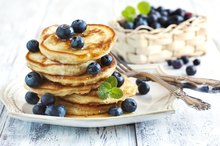What does fact checked mean?
At Healthfully, we strive to deliver objective content that is accurate and up-to-date. Our team periodically reviews articles in order to ensure content quality. The sources cited below consist of evidence from peer-reviewed journals, prominent medical organizations, academic associations, and government data.
The information contained on this site is for informational purposes only, and should not be used as a substitute for the advice of a professional health care provider. Please check with the appropriate physician regarding health questions and concerns. Although we strive to deliver accurate and up-to-date information, no guarantee to that effect is made.
What Causes Gout and Bursitis?
Gout and bursitis can cause severe and debilitating pain in the joints. While gout affects the joints themselves, bursitis affects the fluid sacs called bursae that help eliminate friction at joints or spots where the muscles and tendons rub over bony projections. Gout occurs when sharp urate crystals accumulate in the joints and surrounding areas. In contrast, bursitis occurs when bursae become inflamed from any cause.
If you are experiencing serious medical symptoms, seek emergency treatment immediately.
Overexertion
Bursitis most often affects the joints of the hips, elbows and shoulders, but can also affect the heels, knees and big toes. Gout usually attacks the joints of the big toes, but can also occur in the feet, ankles and knees, and hands and wrists. Unlike gout, bursitis often occurs as a result of simple overuse, especially in middle-aged people, according to PubMed Health. Avoiding such triggers can solve the problem for many bursitis sufferers.
- Bursitis most often affects the joints of the hips, elbows and shoulders, but can also affect the heels, knees and big toes.
Arthritis
Diseases That Mimic Gout
Learn More
Gout is a form of arthritis, and patients who have arthritis have an elevated risk for developing bursitis. Arthritis encompasses a range of conditions that cause inflammation and gradual destruction of a joint. The inflammation can spread to the bursae, causing bursitis. MedlinePlus.com classifies gout as a type of arthritis 1.
- Gout is a form of arthritis, and patients who have arthritis have an elevated risk for developing bursitis.
Urate Crystals
Gout results when levels of uric acid in the blood rise too high, causing formation of spiky urate crystals that invade the joints or the spaces around them. Uric acid forms as the body breaks down purines, a protein component found in many foods, and also made by the body. Normally, the kidneys efficiently filter out uric acid from the blood, but crystals can form if the kidneys falter or the body makes too much uric acid. The Merck Manual states that although the exact cause of bursitis often remains a mystery, it can result from invasion of crystals into the bursae.
- Gout results when levels of uric acid in the blood rise too high, causing formation of spiky urate crystals that invade the joints or the spaces around them.
Other Factors
How to Dissolve Gout Crystals
Learn More
Both bursitis and gout become more common in middle-age, perhaps because of accumulated wear-and-tear on joints and the development of other conditions that affect the joints. For example, people with thyroid disease have an elevated risk for bursitis, while diabetes increases the risk of both bursitis and gout. Other risk factors for gout include kidney disease, high blood pressure and high cholesterol, drinking alcohol and eating purine rich foods, because all of these factors increase the levels of uric acid in the blood.
Related Articles
References
- National Institutes of Health: MedlinePlus: Gout
- National Institute of Arthritis and Musculoskeletal and Skin Diseases. Gout. Updated April 2016.
- Zhang Y, Chen C, Choi H, et al. Purine-rich foods intake and recurrent gout attacks. Ann Rheum Dis. 2012; 71(9):1448-53. doi:10.1136/annrheumdis-2011-201215
- Fischer E. Ueber die Harnsauer. 1 [On Uric Acid. 1]. Berichte der Deutschen Chemischen Gesellschaft. 1884: 17:328-338. doi:10.1002/cber.18980310304
- Ragab, G., Elshahaly, M., & Bardin, T. (2017). Gout: An old disease in new perspective – A review. Journal of Advanced Research, 8(5), 495–511. doi:10.1016/j.jare.2017.04.008
- Centers for Disease Control and Prevention. Gout. Updated January 28, 2019.
- Zgaga, L., Theodoratou, E., Kyle, J., Farrington, S. M., Agakov, F., Tenesa, A., … Campbell, H. (2012). The Association of Dietary Intake of Purine-Rich Vegetables, Sugar-Sweetened Beverages and Dairy with Plasma Urate, in a Cross-Sectional Study. PLoS ONE, 7(6), e38123. doi:10.1371/journal.pone.0038123
- Choi HK, Gao X, Curhan G. Vitamin C intake and the risk of gout in men: a prospective study. Arch Intern Med. 2009;169(5):502–507. doi:10.1001/archinternmed.2008.606
- Zhang Y, Neogi T, Chen C, Chaisson C, Hunter DJ, Choi HK. Cherry consumption and decreased risk of recurrent gout attacks. Arthritis Rheum. 2012;64(12):4004–4011. doi:10.1002/art.34677
- Arthritis Foundation. Gout Diet: Dos and Don’ts.
- Boban M, Modun D. Uric acid and antioxidant effects of wine. Croat Med J. 2010;51(1):16–22. doi:10.3325/cmj.2010.51.16
- Caliceti C, Calabria D, Roda A, Cicero AFG. Fructose Intake, Serum Uric Acid, and Cardiometabolic Disorders: A Critical Review. Nutrients. 2017;9(4):395. Published 2017 Apr 18. doi:10.3390/nu9040395
- U.S. Department of Health and Human Services and U.S. Department of Agriculture. 2015–2020 Dietary Guidelines for Americans. 8th Edition. Published December 2015.
- U.S. Department of Health and Human Services. Gripped by Gout. NIH News in Health. Published February 2014.
- Kakutani-Hatayama M, Kadoya M, Okazaki H, et al. Nonpharmacological Management of Gout and Hyperuricemia: Hints for Better Lifestyle. Am J Lifestyle Med. 2015;11(4):321–329. Published 2015 Sep 2. doi:10.1177/1559827615601973
Writer Bio
In 20 years as a biologist, Susan T. McClure has contributed articles to scientific journals such as "Nature Genetics" and "American Journal of Physiology." She earned her Ph.D. from the University of Maryland. She enjoys educating people about science and the challenge of making complex information accessible.








